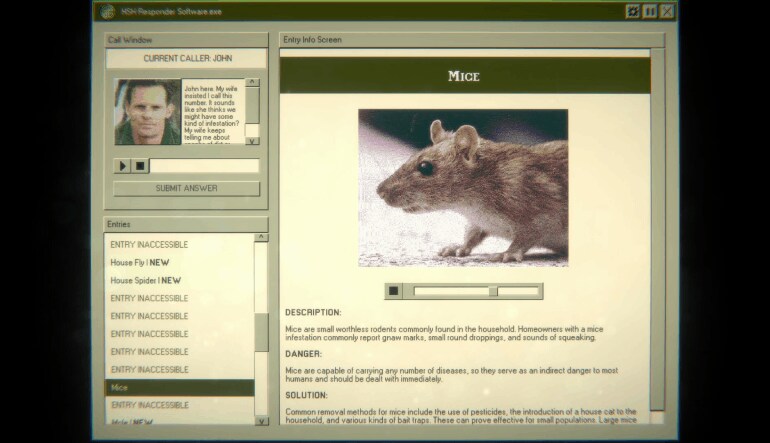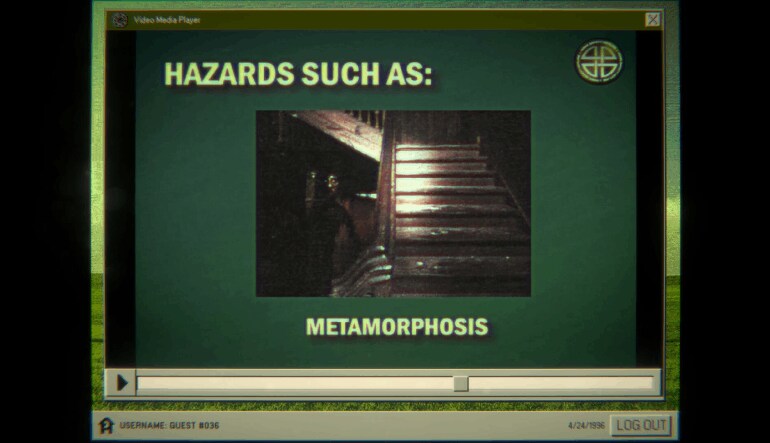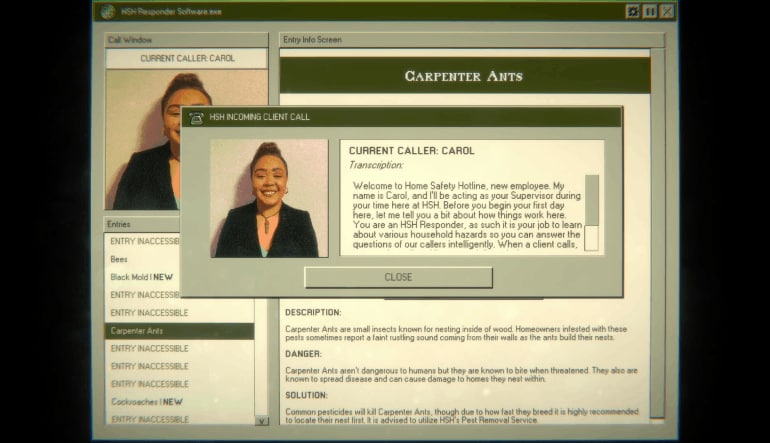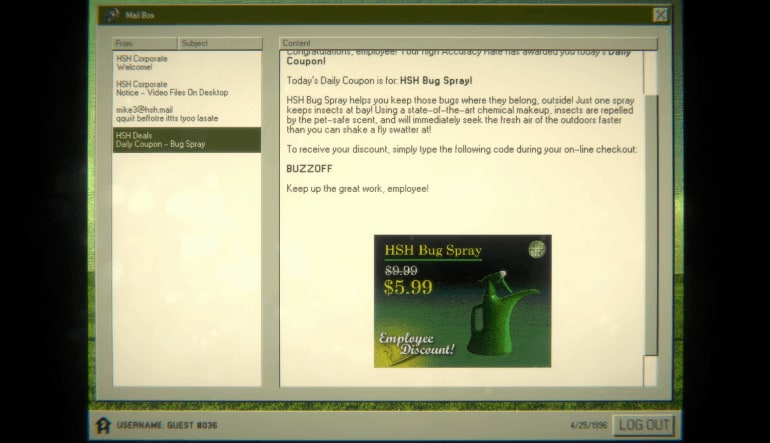Are you ready to help people figure out what’s wrong with their house? Is it a mouse or a ghost? Analyze clues and offer solutions as you work as an emergency responder for the Home Safety Hotline.
Home Safety Hotline is an analog horror simulation game where the primary job of your character is to respond to calls from people in distress as they’re looking for help in identifying and solving a variety of issues in their houses, from completely harmless to extremely deadly.
Learn about the possible issues and hazards and how to identify them and differentiate one from another to provide accurate solutions for the caller. Be smart and connect the dots; otherwise, you’ll be putting the caller in danger, as the list of potential dangers goes from as simple as mice or bees, to supernatural ones, involving gnomes and malicious, evil spirits.
Gameplay Mechanics
Home Safety Hotline is a game that focuses entirely on responding to calls from people seeking help. For the entirety of the game, you’ll be looking at the screen of an old computer running on a fictional operating system that reminds one you could’ve seen in the ‘90s.
The gameplay loop is as follows: you get the call, where a person describes their problems and frustrations, and then you’ve got to figure out the source of the issue. The problems are related to what’s happening in your callers’ houses. It could be hearing a weird noise coming from the basement, noticing a change in someone’s behavior, feeling someone’s presence, or being exposed to a foul smell, among many other potentially suspicious events.
Your job is to study carefully the hints you were given and then figure out what could be causing the trouble.
You’ll have access to a library of hazards where each possible issue is thoroughly described. You can use it to learn more about each particular case, which will help in correctly identifying the threat. Some creativity and thinking out of the box may be required, but not enough to make your head spin.
Once you think you have done the right thing, you can get back to the caller and provide them with a solution. You won’t instantly know if the choice was correct, though; if you got it wrong, the caller will get back to you later, complaining about your advice having no effect whatsoever, but you won’t be able to fix the mistake.
As such, it’s important to remember each call and the problem, as well as the solution you provided, so whenever you decide to replay the game, you’ll know which answer is wrong. Getting high enough accuracy will reward you with some Easter Eggs.
The game does not have a multiplayer mode.
Story
The game doesn’t exactly follow a story and has no real story depth, but it establishes some background and explains your current situation. You’re basically an emergency hotline responder tasked with helping people with their various house issues.
A supervisor will occasionally contact you, giving advice, praising you for good results, and encouraging you to go further, but that’s as far as the lore setup goes. Beyond that, you’re simply doing your job and trying to perform as well as possible while solving increasingly difficult – and ominous – tasks.
Atmosphere
The game offers a surprisingly relaxing atmosphere for a horror game. It doesn’t have jump scares and won’t try to get you by surprise, but you may find certain parts of the game eerie and unsettling. It makes you feel safe, only to disturb that feeling later, but in a very subtle and non-invasive way.
It’s more like a psychological horror that prefers to keep the player in suspense, building tension and making the player expect something to happen at any time, rather than bombarding them with scary stuff.
As the game progresses, you’ll unlock more identifiable threats and you’ll quickly notice that some of them are getting rather ridiculous, which creates a weird sensation of something feeling off. That’s because everything is presented in a rather believable way. It does feel like Home Safety Hotline is a real thing and it could’ve very well been operating as a real service in the ‘90s.
Anxiety starts to kick in once the library of threats gets updated with entries such as “bed teeth”, “portals”, “travel gnomes”, weird mushrooms singing in harmony, or artifacts disguised as an ordinary object, trapping unaware people inside forever.
If you have ever had anything to do with the SCP Foundation, you’ll know what we’re talking about; it’s a fiction that feels oddly real.
User Interface
The game’s interface is, in its entirety, a computer screen with a retro operating system installed. Navigating through the menus is simple, as there’s not much to click through. It’s easy to learn and intuitive to use. It feels like using a real computer from the ‘90s, with all the classic-looking windows and pop-ups.
It perfectly imitates the genuine experience, especially considering that things don’t launch instantly when you click the icons; there’s a slight delay that makes you think that the PC is actually processing your request in real time.
The same goes for the hazard entries you’ll be reading through; when you click on the chosen entry, it’s not instantly loaded, but instead, loads slowly in chunks of content, as you would expect from an old PC system with limited memory.
Score and Sound
The music in Home Safety Hotline is scarce, to the point of being almost non-existent – its presence is limited to very few situations. There is some music playing when you ask the caller to hang on while you’re trying to connect the dots and it’s the exact kind of “elevator” music you’d expect to hear – a chill, relaxing looped track that serves the same purpose as in real life: to make the waiting process for the caller a little bit more bearable.
There is also some music playing in various instructional videos in the game, purposefully made in rather low quality to imitate the retro style of the ‘90s. However, in general, the game is rather silent in terms of music.
Sounds are simple but add a lot to the overall atmosphere of the game. As the action of Home Safety Hotline takes place in the ‘90s and has you staring at the computer screen, you can expect a variety of sound effects related to a retro computer system you’ll be working with, with lots of beeps and clicks as you navigate through the menus.
There are also sound recordings for a majority of entries in the hazard library to make it easier to identify the caller’s issue. Some can be unsettling, which adds some anxiety and a sense of uncertainty and tension.
Replayability
The game has a certain degree of replayability. It doesn’t exactly encourage players to play the game multiple times, but if you don’t get the correct answers often enough, you’ll fail, forcing you to start over if you want to get to the final part, which instantly brings a rogue-like formula to mind and has a lot in common with games such as Five Nights at Freddy’s.
Those with a completionist mentality will have more reason to replay the game even after it’s been beaten; that’s because the developers prepared small Easter Eggs for those who manage to get particularly high accuracy in correctly identifying the threats.
Guessing the correct answers and aiming for 100% accuracy can also be a goal on its own, but it’s certainly not everyone’s cup of tea and it’s more like one of the self-imposed challenges rather than something you’d be expected to do.
One of the recent updates added an endless mode to the game, giving a bit more incentive for players to return to Home Safety Online and try to correctly identify as many anomalies as possible. There are a lot of them to be seen; try to discover and solve all the available cases.
Unlike the story mode, here you’ll have to work under constant time pressure though, so familiarizing yourself with all the possible threats to be able to quickly answer each call will be vital in obtaining a high score. See how far you can get and compare the scores with your friends.
Pros and Cons
As a short summary of the game’s strengths and weaknesses, here’s a compact and convenient list of the most important pros and cons.
Pros:
- Very easy to learn the rules
- Feels very realistic – combines real setting with supernatural elements in a very believable way
- Unique gameplay experience that requires a bit of creative thinking
- Clean UI based on an interface of a PC operating system inspired by the ones from the ‘90s
- An unlockable endless mode for some extra fun after the game is finished
Cons:
- Rather short if you get the answers right on your first playthrough, losing a bit of its replay value
- No time limit in the story mode takes away from the immersion, as you’re allowed to put the caller on hold indefinitely, which kills the tension and any sense of urgency
- Can get repetitive if you play more than once, as you’ll already have a number of correct answers memorized
- Lacks ongoing stories and branching chain events that would be connected to earlier calls
- Riddles are not difficult enough to pose a real challenge
Conclusion
Home Safety Hotline is a fun little game that can give you a dose of entertainment in a realistic retro setting.
It manages to perfectly blend completely believable scenarios with supernatural elements, which creates an atmosphere with an unsettling aura of uncertainty, stripping you of any sense of security you might have felt at your fictional workplace.
It’s not a scary horror game but it does feel odd and eerie at times, especially when you get calls from suspicious individuals. Definitely an interesting experience you wouldn’t want to miss.









